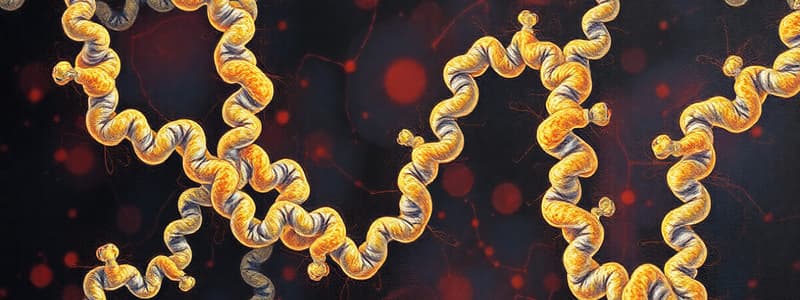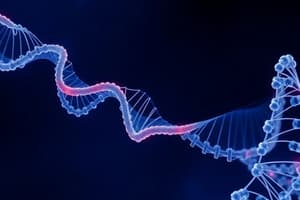Podcast
Questions and Answers
What is the primary structure of a protein?
What is the primary structure of a protein?
- The three-dimensional shape of a polypeptide
- The sequence of amino acids in a polypeptide (correct)
- The folding patterns of a polypeptide chain
- The overall function of the protein
Tertiary structure refers to the sequence of amino acids in a polypeptide.
Tertiary structure refers to the sequence of amino acids in a polypeptide.
False (B)
What bonds play a significant role in maintaining tertiary structure?
What bonds play a significant role in maintaining tertiary structure?
Hydrophobic interactions, ionic interactions, hydrogen bonds, and Van der Waals interactions.
The __________ structure involves localized, repeating shapes such as α helices and β-pleated sheets.
The __________ structure involves localized, repeating shapes such as α helices and β-pleated sheets.
Match the following protein structure levels with their descriptions:
Match the following protein structure levels with their descriptions:
Which amino acid is represented by the abbreviation 'Ala'?
Which amino acid is represented by the abbreviation 'Ala'?
Glycosylation is a process that involves the addition of sugar molecules to proteins.
Glycosylation is a process that involves the addition of sugar molecules to proteins.
What are the two terminal ends of a polypeptide chain called?
What are the two terminal ends of a polypeptide chain called?
What component is primarily responsible for the formation of peptide bonds between amino acids?
What component is primarily responsible for the formation of peptide bonds between amino acids?
The Golgi apparatus is primarily responsible for the initial synthesis of proteins.
The Golgi apparatus is primarily responsible for the initial synthesis of proteins.
Name the specific sites on a ribosome where tRNAs bind during translation.
Name the specific sites on a ribosome where tRNAs bind during translation.
A protein that consists of multiple polypeptide chains has a __________ structure.
A protein that consists of multiple polypeptide chains has a __________ structure.
Match the following levels of protein structure with their descriptions:
Match the following levels of protein structure with their descriptions:
Which process affects the functionality of proteins by modifying amino acid sequences post-translation?
Which process affects the functionality of proteins by modifying amino acid sequences post-translation?
Elongation factors use ATP for energy during polypeptide elongation.
Elongation factors use ATP for energy during polypeptide elongation.
What is the role of charged tRNAs during the process of translation?
What is the role of charged tRNAs during the process of translation?
What is the function of the Golgi apparatus?
What is the function of the Golgi apparatus?
The hydrophobic effect causes polar amino acids to cluster in the center of a protein structure.
The hydrophobic effect causes polar amino acids to cluster in the center of a protein structure.
What are the primary levels of protein structure?
What are the primary levels of protein structure?
Glycosylation is the process of adding ________ to proteins.
Glycosylation is the process of adding ________ to proteins.
Match the type of amino acid with its property:
Match the type of amino acid with its property:
During glycosylation, carbohydrates are often attached to which part of a protein?
During glycosylation, carbohydrates are often attached to which part of a protein?
Nonpolar amino acids are generally found on the exterior of proteins where they are exposed to water.
Nonpolar amino acids are generally found on the exterior of proteins where they are exposed to water.
What effect does amino acid sequence have on protein function?
What effect does amino acid sequence have on protein function?
The ________ effect is crucial for maintaining protein structure by causing nonpolar amino acids to avoid water.
The ________ effect is crucial for maintaining protein structure by causing nonpolar amino acids to avoid water.
Match the levels of protein structure with their definitions:
Match the levels of protein structure with their definitions:
What role do chaperones play in protein folding?
What role do chaperones play in protein folding?
Which of the following disorders is associated with the accumulation of misfolded proteins?
Which of the following disorders is associated with the accumulation of misfolded proteins?
What is the consequence of a mutation in a protein's amino acid sequence?
What is the consequence of a mutation in a protein's amino acid sequence?
How are proteins that cannot fold properly handled by the cell?
How are proteins that cannot fold properly handled by the cell?
Which of the following statements is true regarding incorrectly folded proteins?
Which of the following statements is true regarding incorrectly folded proteins?
Which of the following accurately describes quaternary structure in proteins?
Which of the following accurately describes quaternary structure in proteins?
Which factor does NOT contribute to protein folding and stability?
Which factor does NOT contribute to protein folding and stability?
What characterizes the secondary structure of a protein?
What characterizes the secondary structure of a protein?
Which of the following is a type of bond that plays a key role in maintaining tertiary structure?
Which of the following is a type of bond that plays a key role in maintaining tertiary structure?
What type of interactions do ionic bonds facilitate in protein stability?
What type of interactions do ionic bonds facilitate in protein stability?
What is the significance of glycosylation in protein sorting?
What is the significance of glycosylation in protein sorting?
Which of the following best describes the quaternary structure of proteins?
Which of the following best describes the quaternary structure of proteins?
What is primarily responsible for maintaining the tertiary structure of proteins?
What is primarily responsible for maintaining the tertiary structure of proteins?
What does the primary structure of a protein refer to?
What does the primary structure of a protein refer to?
How does phosphorylation affect proteins post-translation?
How does phosphorylation affect proteins post-translation?
Which characteristic is associated with the secondary structure of proteins?
Which characteristic is associated with the secondary structure of proteins?
What role do signal sequences play in protein sorting?
What role do signal sequences play in protein sorting?
What is the result of cleaving proinsulin during post-translational processing?
What is the result of cleaving proinsulin during post-translational processing?
Flashcards are hidden until you start studying
Study Notes
Protein Structure
- Primary Structure: Refers to the specific sequence of amino acids in a polypeptide chain. This sequence determines the protein's overall structure and function.
- Secondary Structure: Localized, repeating shapes in the polypeptide chain, formed by bonds between nearby amino acids. Examples include the α-helix and β-pleated sheet.
- Tertiary Structure: Three-dimensional conformation of a protein resulting from folding of secondary structures. This fold is influenced by various interactions including hydrophobic, ionic, hydrogen bonds, and Van der Waals forces. This structure represents the final conformation for proteins composed of a single polypeptide chain.
Polypeptide Elongation
- Requires energy from GTP, and involves the recruitment of elongation factor (EF) proteins.
- Elongation occurs in three steps:
- Step 1: Charged tRNAs are recruited to the A-site with the help of EFs.
- Step 2: Peptide bonds are formed between sequential amino acids.
- Step 3: The ribosome translocates in the 3' direction along the mRNA.
Polypeptide Elongation in Bacteria
- EFs are involved in elongation and aid in a series of steps.
- Charged tRNAs with matching anticodons to the mRNA sequence enter the A-site.
- Peptidyl transferase catalyzes the formation of peptide bonds between amino acids at the P and A sites.
- The polypeptide is transferred to the tRNA at the A-site while the tRNA from the P-site exits through the E-site.
Hydrophobic Effect
- Nonpolar amino acids tend to cluster in the center of a protein, avoiding contact with water. This contributes to the protein's tertiary structure.
Protein Structure
- Quaternary Structure: Occurs when two or more polypeptides (protein chains) associate with each other through weak bonds to form a functional protein. An example is hemoglobin A
- Factors that promote protein folding and stability: Hydrogen bonds, ionic bonds and other polar interactions, hydrophobic effects, Van der Waals forces, and disulfide bridges.
- Protein Folding and Stability: Correct folding is critical for function. Mutations in the amino acid sequence can affect protein folding and stability, potentially leading to dysfunction.
- Chaperones and Protein Folding: Incorrectly folded proteins within the endoplasmic reticulum are bound by chaperones, helping them fold correctly. If folding fails, a chaperone-protein complex is formed and sequestered for destruction.
Disorders Associated with Incorrect Protein Folding
- Diseases like Alzheimer's, Parkinson's, and Huntington's can occur when misfolded proteins accumulate.
- Prion diseases, including mad cow disease, chronic wasting disease, and Creutzfeldt-Jakob disease, are caused by transmissible misfolded proteins.
Polypeptide Processing
- Post-translational polypeptide processing: Modifies polypeptides to become functional proteins through removal or chemical alteration of amino acids.
- Modifications: Examples include removal of methionine (Met), addition of -CH3, -OH, -COCH3, and phosphorylation (addition or removal of phosphate groups, kinases), and cleavage into multiple segments.
- Insulin Example: The hormone insulin is first produced as preproinsulin. Cleavage removes the "pre-amino" segment, resulting in proinsulin. Further cleavage produces the functional insulin, consisting of two chains held together by disulfide bonds.
Protein Sorting
- Signal Sequences: Determine protein destination. The first 15-20 amino acids on the N-terminus are used by the endoplasmic reticulum and Golgi apparatus to direct protein transport.
- Golgi Apparatus in Protein Sorting: The Golgi apparatus adds carbohydrate side chains (glycosylation) to proteins, determining their final locations based on receptor recognition.
Protein Structure – Levels
- Primary Structure: Amino acid sequence of the polypeptide chain.
- Secondary Structure: The folding of the polypeptide chain into alpha helices and beta sheets.
- Tertiary Structure: The three-dimensional shape of a single polypeptide chain.
- Quaternary Structure: The arrangement of multiple polypeptide chains in a protein complex.
Studying That Suits You
Use AI to generate personalized quizzes and flashcards to suit your learning preferences.



